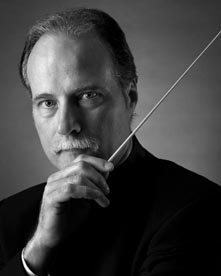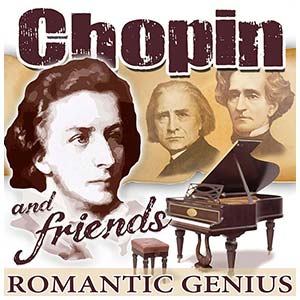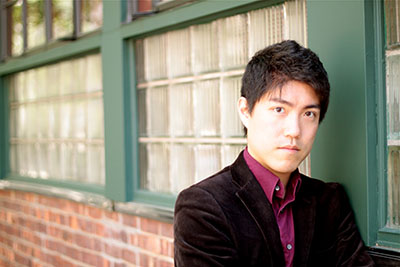Roman Carnival Overture
Hector Berlioz (1803 – 1869)
“Little Fugue” in G Minor
J.S. Bach (1685 – 1750)
Festive March for Goethe Centenary
Franz Liszt (1811 – 1886)
Piano Concerto No. 1 in E Minor
Frédéric Chopin (1810 – 1849)
Ryo Yanagitani, pianist
Ryo Yanagitani is one of Canada’s most promising young concert artists. His most recent success includes winning the gold medal at the 10th San Antonio International Piano Competition, where he was also given special recognition for a performance of the complete Chopin Ballades. Among other honors, he is also the grand prize winner of the Hugo Kauder International Piano Competition and a laureate of the Minnesota International Piano-e-Competition, the Dr Luis Sigall International Piano Competition in Vina del Mar (Chile), and the Hilton Head International Piano Competition.
Mr Yanagitani received his Masters of Music degree from the Yale School of Music under Boris Berman, a Bachelors Degree in Piano Performance from the University of British Columbia under Doctor Henri-Paul Sicsic and an Artist Diploma from the Cleveland Institute under Sergei Babayan. He recently completed his residency requirement of the Yale School of Music Doctor of Musical Arts Degree, and currently resides in New Haven, Connecticut.

Gene Dowdy
Conductor & Artistic Director
Conductor’s Letter
Dear Friends,
Our fourth concert of the season will bring one of the brightest young stars of the piano world to the Cailloux Theater, accompanied by the Symphony of the Hills. We will feature the Gold Medal Winner of the 10th San Antonio International Piano Competition, Ryo Yanagitani, a brilliant Canadian artist performing Chopin’s powerful Piano Concerto No. 1 in E Minor. Ryo also was given special recognition at the competition for his performance of Chopin. Incidentally, the San Antonio International Piano Competition has a new name thanks to Musical Bridges Around the World’s organizational leadership: it is now known as The Gurwitz International Piano Competition, named in honor of legendary pianist, educator, and philanthropist Ruth Jean Gurwitz. The 2020 Gurwitz competition will have taken place in early February of 2020 just before this performance! We welcome any friends of the Gurwitz competition to this special performance.
While most of us know all about Chopin’s virtuosic piano performance and compositional skills, another aspect of his legendary personae was his friendships and rivalries during his lifetime, including close associations with Hector Berlioz and Franz Liszt. Chopin was also highly influenced by the music of J.S. Bach. We will open the concert with Berlioz’s flamboyant “Roman Carnival Overture,” one of the most thrilling concert works written in the 19th Century by one of Chopin’s best friends. Next, the orchestra will pay homage to one of Chopin’s greatest influences, J.S. Bach, by performing the “Little Fugue in G Minor” in a colorful arrangement by Lucien Caillet. Closing out the first half, we turn to the music of Chopin’s sometimes friend, sometimes arch-rival Franz Liszt, who wrote his Festive March in celebration of the centennial of Goethe’s birth.
The second half of the concert brings Mr. Yanagitani to the stage for the Chopin Piano Concerto No. 1 in E Minor. This powerful and evocative concerto will captivate every one of us in attendance. I hope to see you there!
With sincere thanks for your support,
Gene Dowdy, Conductor & Artistic Director
Concert Notes
We have come to think of Frédéric Chopin as a leading symbol of the Romantic era. His influence on Western music was, and still is, immeasurable. However, when considering Chopin and his works, it would be interesting to consider those other composers who were influential in his developing into the creative genius we love today. Tonight, we will touch on the lives and music of those composers who were closest to him.
Roman Carnival Overture
Hector Berlioz (1803 – 1869)
Attending Berlioz’s 1832 concert at the Conservatoire in Paris were several contemporary celebrities including Paganini, Liszt and Chopin. A close friendship developed between Berlioz and Chopin although they were polar opposites. Berlioz had an outsized personality, controversial public persona, and an erratic symphonic genius. Chopin had none of these, except the “genius” part. Both were stars in a remarkable, creative constellation of artists flourishing in Paris at the time.
Louis-Hector Berlioz was a French Romantic composer. The elder son of a provincial doctor, Berlioz was expected to follow his father into medicine, but he had different ideas; indeed, he was revolted by much of what was typical medical practice at the time. In stark contrast to his abhorrence of medicine, he loved the opera and began composing serious music before he finished medical school in 1824. The first concert of Berlioz’s music took place in 1828. It wasn’t financially successful but Berlioz was encouraged by the enthusiasm of the audience and musicians. Over the next several decades he composed 4 symphonies, 3 operas and countless shorter musical pieces, most of which have been commercially recorded.
The Roman Carnival Overture was composed by Berlioz in 1844 using themes from his opera Benvenuto Cellini, which was unpopular and with which he had become dissatisfied. In the words of the composer, the Overture possesses “energy and exuberance and a brilliance of color such as I may perhaps never find again,” Although the aforementioned opera was a dud, the Overture was instantly successful as a separate concert piece. The “exuberance” and “brilliance of color” are abundant in the Roman Carnival, reflective of a carnival atmosphere.
“Little Fugue” in G Minor
S. Bach (1685 – 1750)
No superlatives are adequate to describe the musical contributions of Johann Sebastian Bach. His experimentation and musical invention has had a significant impact on all composers of the last century and a half. Chopin became very familiar with Bach’s body of work and exploited it to great creative advantage. It is fitting that a well-recognized example of Bach’s music should be included in this concert.
Much has been written about Bach and his influence on classical music (see Music in the Castle of Heaven, a fascinating and exhaustive biography of Bach by John Eliot Gardiner.) Although Bach was greatly admired during his lifetime, he was not widely known until the mid-19th century, when his music gained broad exposure through the efforts of Felix Mendelssohn’s great aunt Sarah. Bach is now considered by many to be the father of modern Western classical composition and by some Bach enthusiasts to be the “original jazz musician.”
Bach wrote at least three Fugues in G Minor. This one, popularly known as the “Little Fugue,” is BWV number 578 in the widely-used catalogue of Bach’s compositions. It is known as the “Little” Fugue not because it is a work of minor importance or even because it is unusually short, but simply to distinguished it from his later “Great” G minor Fantasia and Fugue, BWV 542. The Little Fugue was written about 1705 during Bach’s tenure at Arnstadt and is one of the most recognized and popular of his pieces. It was written for organ, but in the centuries that have followed, it has been rearranged for everything from brass quintet to full orchestra. It is said that if you hum this piece on a crowded elevator, more than half of those around you will join in.
Festive March for Goethe Centenary
Franz Liszt (1811 – 1886)
Franz Liszt was a veritable wellspring of musical composition during his creative period of more than 65 years. Over the full course of his productive life, he composed at least 750 musical works as well as hundreds of essays, commentaries and books on other composers and their works.
Liszt was born in the Kingdom of Hungary, which at the time was part of the Hapsburg Empire, the language of which was German. Although he never spoke Hungarian and was fluent in German, French and Italian, he considered himself Hungarian.
At an early age, Liszt’s father, who was an accomplished amateur cellist, immersed young Franz in the complete works of Bach, Mozart, Beethoven and others, and drilled him on piano. Young Liszt was a good student and began to compose music at the age of eight. He made his first public appearance as a concert pianist at age nine. His playing so impressed the Hungarian elite that they put up the money to pay for his musical education for the next six years.
In 1823, the Liszt family left Vienna for Paris, where Liszt made a living by teaching piano and playing in private circles. He gave several concerts in 1824, quickly increasing his popularity and virtuosity.
During the winter 1831–32, Liszt became acquainted with Mendelssohn and Chopin, both of whom had arrived in Paris with suitcases full of masterworks. The relationship between Liszt and Chopin was choppy; nevertheless, Liszt became Chopin’s agent, collaborator, personal friend, bitter rival, and ultimately, his first biographer. Both Chopin and Liszt are indelibly linked with the piano. They were born within a year of each other, and both achieved their greatest fame in Paris. And it was Liszt who claimed to have been the one to introduce Chopin to his eventual lover George Sand (see below.)
As a composer, Liszt, not unlike Chopin, radically extended the technique of piano writing, giving the instrument not only brilliance but a full, rich, almost orchestral sound. Liszt invented the symphonic poem for orchestra and the method of “transformation of themes,” by which one or two themes in different forms can provide the basis for an entire work—a principle from which Wagner derived his system of so-called leitmotifs in opera.
Liszt’s Festive March, written in 1849 for the celebration of Goethe’s 100th birthday, represented only a small fraction of Liszt’s creative efforts in that year as an homage to Goethe. Over the next 10 years, he made adjustments to the piece and conducted the latest version in 1859. The march is exactly what one would expect: lively, brassy and festive.
Piano Concerto No. 1 in E Minor
Frédéric Chopin (1810 – 1849)
Ryo Yanagitani, Pianist
The Polish composer and virtuoso pianist of the Romantic era Frédéric Chopin wrote primarily for solo piano. His incomparable musical invention has led to his worldwide recognition as a leading musician of his era. “Chopin,” Berlioz once wrote, “is an artist apart; he has no point of resemblance with any other musician . . .”
Chopin was born Fryderyk Franciszek Chopin in the Duchy of Warsaw and grew up in Warsaw proper. His parents were French/Polish, coming from the area around Loraine, France, which earlier had been part of Poland. Both of his parents were skilled musicians. His father was a teacher who played the flute and violin; his mother sang and played the piano proficiently. The atmosphere in the family home was warm and hearty, a place imbued with the character of Polish aristocracy. It would remain for Chopin a symbol of peace, security and love that the composer would cherish throughout his adult life, (sadly cut short by pericarditis, a rare complication of chronic tuberculosis.)
As a youngster Chopin was recognized as a prodigy by his piano teacher. He composed his earliest works in Warsaw before leaving Poland for Paris via Vienna at the age of 20. He supported himself by selling his compositions and by giving piano lessons. Still as a young man he maintained a troubled relationship with the French writer six years his senior, Amantine Dupin known by her pen name, George Sand.
Many of Chopin’s piano compositions expanded the technical limits of the instrument and were fiendishly difficult to play. His major piano works include mazurkas, waltzes, nocturnes, polonaises, études, impromptus, scherzos, preludes and sonatas. He gained his inspirations from Polish folk music, classical structures of J.S. Bach, Mozart, and Schubert, and the atmosphere of the Paris salons where he was a frequent guest.
The Piano Concerto No. 1, in 3 movements, was written by Chopin in 1830, when he was twenty years old. It was first performed in Warsaw that year by Chopin himself, shortly before he left for Paris. The 1st movement has three themes, which are introduced by the orchestra, then repeated by the piano. The 2nd movement, the Romanze, is described by the composer in a letter, “It is not meant to create a powerful effect; it is rather a romance, calm and melancholy, giving the impression of someone looking gently towards a spot that calls to mind a thousand happy memories.” Indeed. The 3rd movement, probably familiar to most of us and described by Chopin as being “difficult”, features a syncopated, double-time dance which is a popularly performed by pianists to demonstrate proficiency, which it certainly accomplishes.
Concert Notes by Jim Adams






